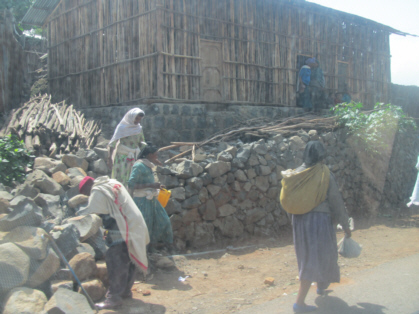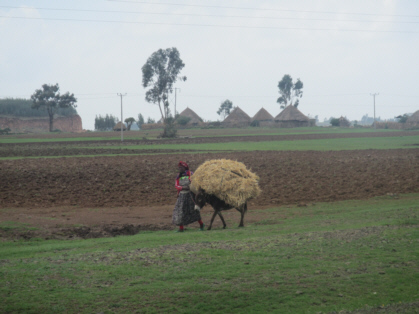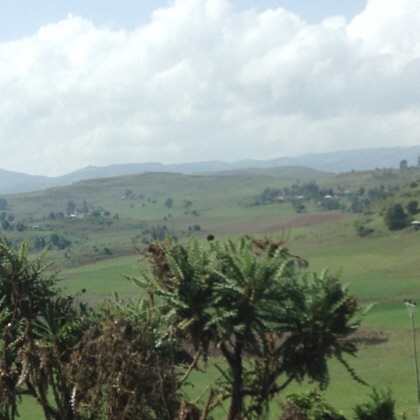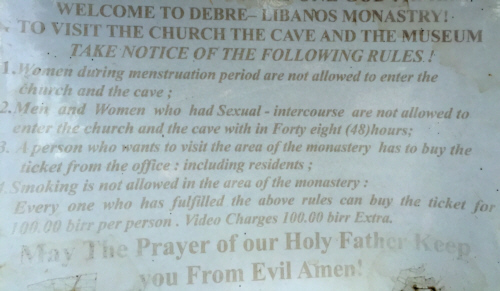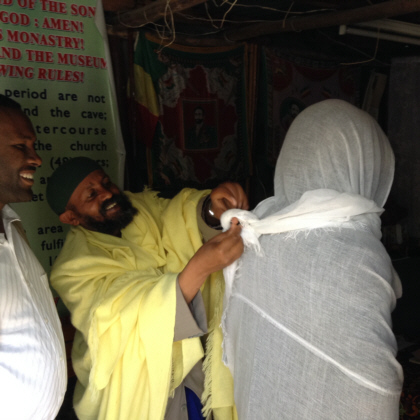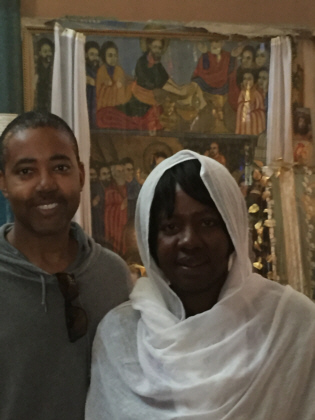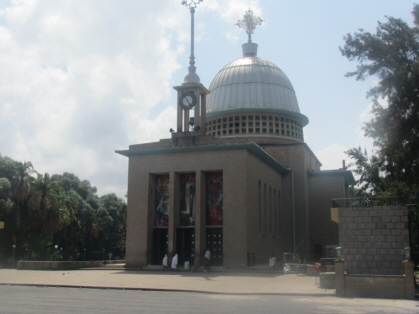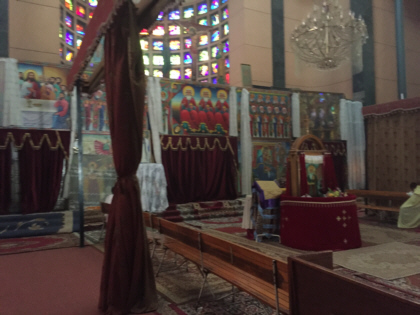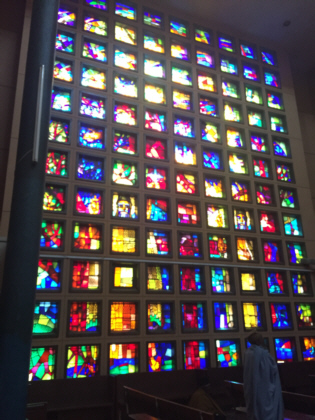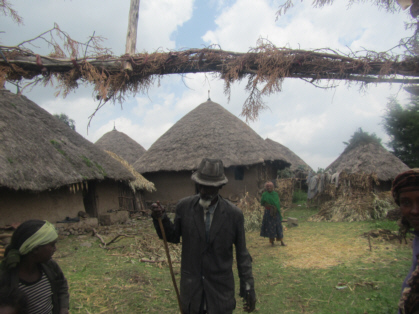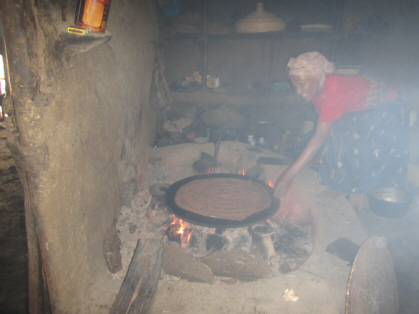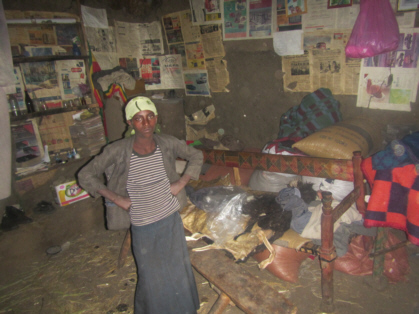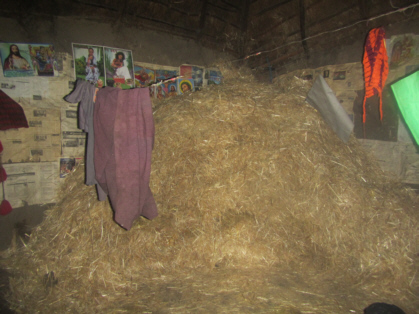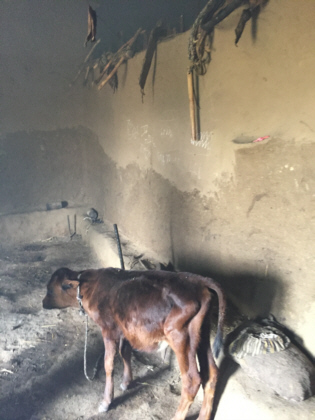Countryside Tour
The next morning, we were met by our guide from the previous day. He said he would not be leading our tour because he needed to catch up on work at the office. Instead, he introduced us to our new driver and our new guide.
We were soon on our way. We left the car-filled streets of Addis and were driven into the mountains. The landscape began to level off and we found ourselves riding through very green lush farmland. About 85% of Ethiopia’s population is agricultural people. The people we saw generally did not use motorized equipment to work the fields. Instead they use animal or human power. As we traveled through the country towns, it seemed like we were traveling back in time. We saw less and less cars but more people traveling by horse and buggy or walking. The houses were made of mud with thatched/straw roofs. As we got higher into the mountains, the towns began to look more like they were the scene of a bible story. Donkeys, cattle, goats, and sheep roamed the streets. The people were dressed as if they were preparing to take part in a live nativity scene. However, this was no act. It was normal attire for these small villages.
Ethiopian Countryside
We arrived at Debra Libanos Monastery. Our guide told us this is a very holy place. A monastery has existed here since the 13th century. However, it has been rebuilt several times due to fire and invasions. The version we saw was built in 1961. To get onto the grounds of the monastery, we had to pass through a gate that was guarded by a man with a rifle. Sprinkled throughout the property were people in deep prayer similar to what we saw at Holy Trinity Cathedral. There were differences, however. There were some people who had covered themselves in ash. Every now and then, I would see a random blanket on the ground. When I looked closer, I saw that there was someone under the blanket praying.
Our guide led us to a shack across from the monastery where we were met by a priest. Our guide and the priest exchanged an elaborate greeting that was comprised of bows, hand grasps, and gestures. The priest then displayed a sign in English on the wall for Traci and me to read. It was a list of strict rules for entering the monastery. The first two rules really stood out: 1. A woman cannot enter if she is on her menstrual cycle 2. People cannot enter if they have had sex within the last 48 hours.
rules for entering the monastery
After reviewing the list of entry rules and affirming to the priest that we were good to go, he needed to dress Traci appropriately for the monastery. He took out a long white linen cloth and wrapped her in it from head to toe. She looked like the Virgin Mary when he was finished. All women must be dressed this way to enter the monastery.
The priest prepares Traci for entering the monastery.
Traci is now dressed appropriately to enter the monastery.
The priest, who I was surprised to learn spoke English very well, began our tour outside the monastery. As he was telling us about its history, I was wishing I was wrapped up like Traci. Those annoying, persistent black flies that I thought we had seen the last of on the Serengeti in Tanzania were here in Ethiopia invading every orifice of my face. Fortunately, we were not outside for long. We had to remove our shoes to enter the monastery. Upon entry, our guide and the priest both made the Sign of the Cross three times and then bowed down several times as if they were going to kiss the floor. Inside was a lot of empty space. There were a few benches. Near the front, there were many religious paintings. Huge Persian-like rugs covered the carpeted floor. The walls contained intricate stained-glass windows depicting bible scenes. All the artwork was done by Ethiopian artists. We were allowed to take photos.
Debra Libanos Monastery
We were led out of the monastery to the nearby museum. Along the way, the priest told me that I look Ethiopian and was wondering if I had family there. I told him that I was not aware of any relatives in the country. Anyway, the priest provided excellent narration of the two-story museum. Like other museums we visited in Ethiopia, it contained religious relics, gifts to/from emperors, and weaponry from the wars with the Italians. He was giving such great commentary that Traci and I eventually noticed we were no longer the only ones in the tour group. There was now at least 10 more people. There was a small souvenir booth at the museum exit. Traci and I bought a refrigerator magnet to add to our collection. There was a different priest who was manning the souvenir booth. He spoke broken English but enough for me to understand that he was trying to tell me that I look Ethiopian. This made our tour guide priest began to laugh and say, "I told you so". I really need to do one of those DNA genealogy tests someday to help me determine my roots. I have wanted to do one for years but have just never gotten around to it.
We left the museum and got back in the van for our return to Addis Ababa. Along the way, we made a stop at a scenic overlook where we could see the Blue Nile. We continued for a couple of hours through mainly farmland. We stopped at a family farm. This did not look like any farms I've seen in the U.S.. These were a group of huts made of mud and a thatched roof. There was a cow feeding in the yard. The children of the family followed Traci and me with curious looks on their faces. We were invited into one of the huts where a lady was making injera on a clay stove. She was using cow manure to fuel the fire. The whole hut was very smoky as she was doing this. The bed was in the same area as the kitchen. Mud walls partitioned other sections of the hut where there was a pile of hay in one room and a calf in another room. It was interesting to see how the people of the country live off the land.
Family Farm
We rode by many farm communities similar to the one we visited. We were supposed to stop to have lunch in one of the small towns but Traci and I opted to wait until we returned to Addis. Our guide reduced our tour price since we did not do the lunch stop that was supposed to be included.
Upon returning to Addis, we were taken to the Ethiopian Quadrants office where we could pay for our tour. I was told I could use my credit card (5% fee applies for doing so) but I could see why cash is preferred. The lady who processed my payment plugged in a dial-up modem to process my card. The first two attempts failed due to network problems. The third time finally worked.
Traci and I had a little over two hours to kill at the hotel before Ethiopian Quadrants would pick us up to take us to the airport. We sat in the lobby and took advantage of the free Wi-Fi during that time.
Our arrival at the airport was a bit nerve-racking. We first had to deal with an aggressive baggage porter. I relented and let him cart our luggage to the airport entrance. He wanted to stay with us all the way through the check-in process but when I told him I only had the equivalent of $1.50 of Ethiopian money left for a tip, he left us in a hurry.
The next issue was security. At Boles Airport, you are required to send all your luggage through the security scanner when you first enter the building. There was only one security person screening the bags. Traci and I had a little laugh because the security guy looked like Kanye West. I am not sure what he was looking for but when Traci and I took our luggage off the belt, he wanted to inspect the contents of each of our four bags. Meanwhile, the security line was getting longer and longer because there was no one else to operate the scanner. The security guard would rummage through our belongings and then go back to scan other passengers' bags that were waiting on the conveyor belt. This cycle went on for at least 10 minutes. Traci and I had had enough, so when he went back to scan other luggage, we grabbed our luggage and headed for the flight check-in counter.
Our 16-hour flight home was long but uneventful. We stopped in Dublin, Ireland for an hour for a crew change but we were not allowed off the plane. We arrived back at Washington Dulles airport around 7:30 AM on a hot and humid morning. Now that we were back home, it was time to tell our friends and family all about our adventurous vacation in Africa. This time, I was even invited to do a presentation of our trip after a staff meeting at work. Continue to Preparing For Our African Adventure...
Ethiopia 1 | Ethiopia 2 | Ethiopia 3
~~~~~~~~~~~~
Intro | Mt. Kilimanjaro Climb | Moshi | Safari | Ethiopia
Preparing For Our African Adventure
Magnet Purchased on this Trip: (click to enlarge)
 Entire fridge magnet collection...
[Back to the Main Page]
Entire fridge magnet collection...
[Back to the Main Page]
